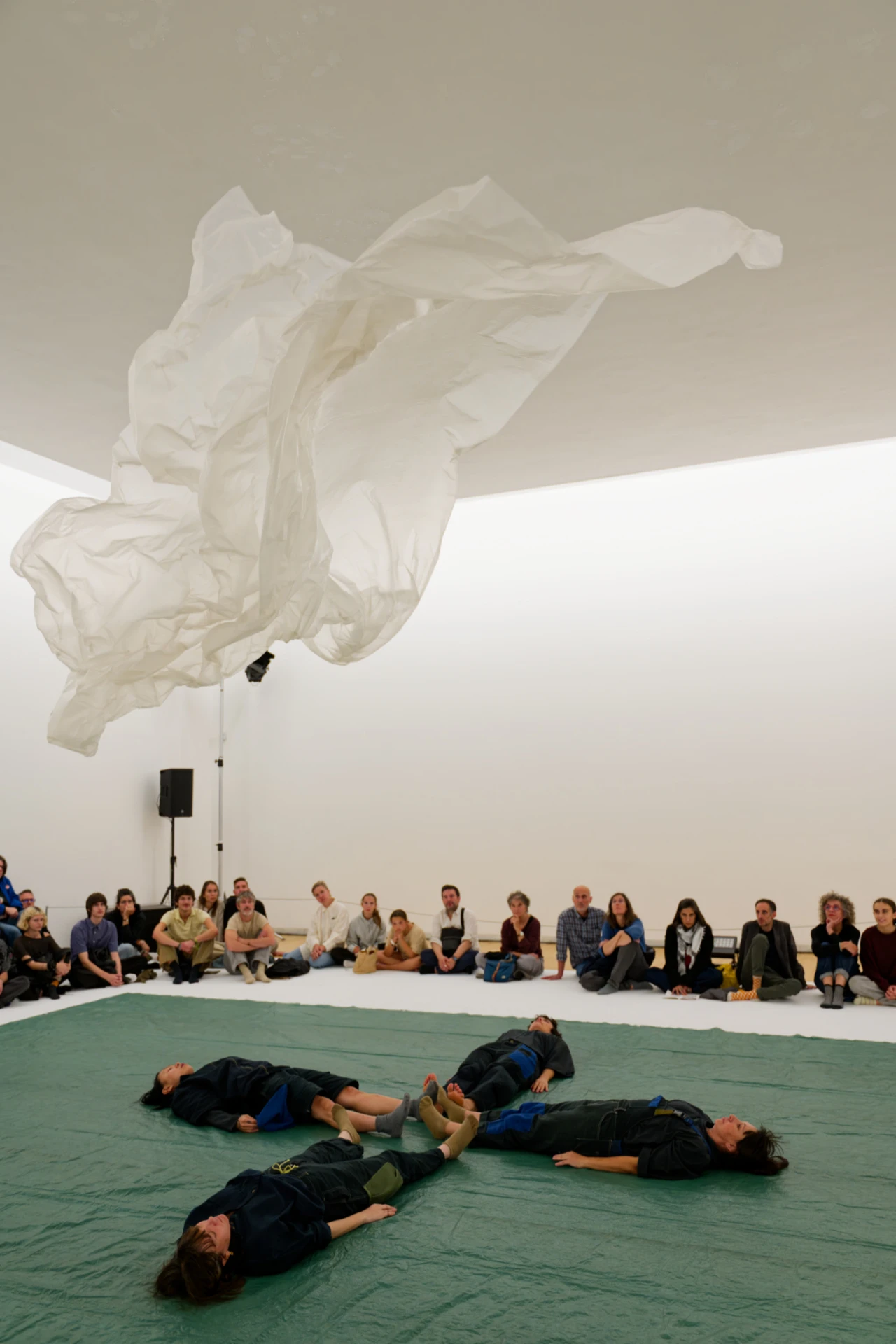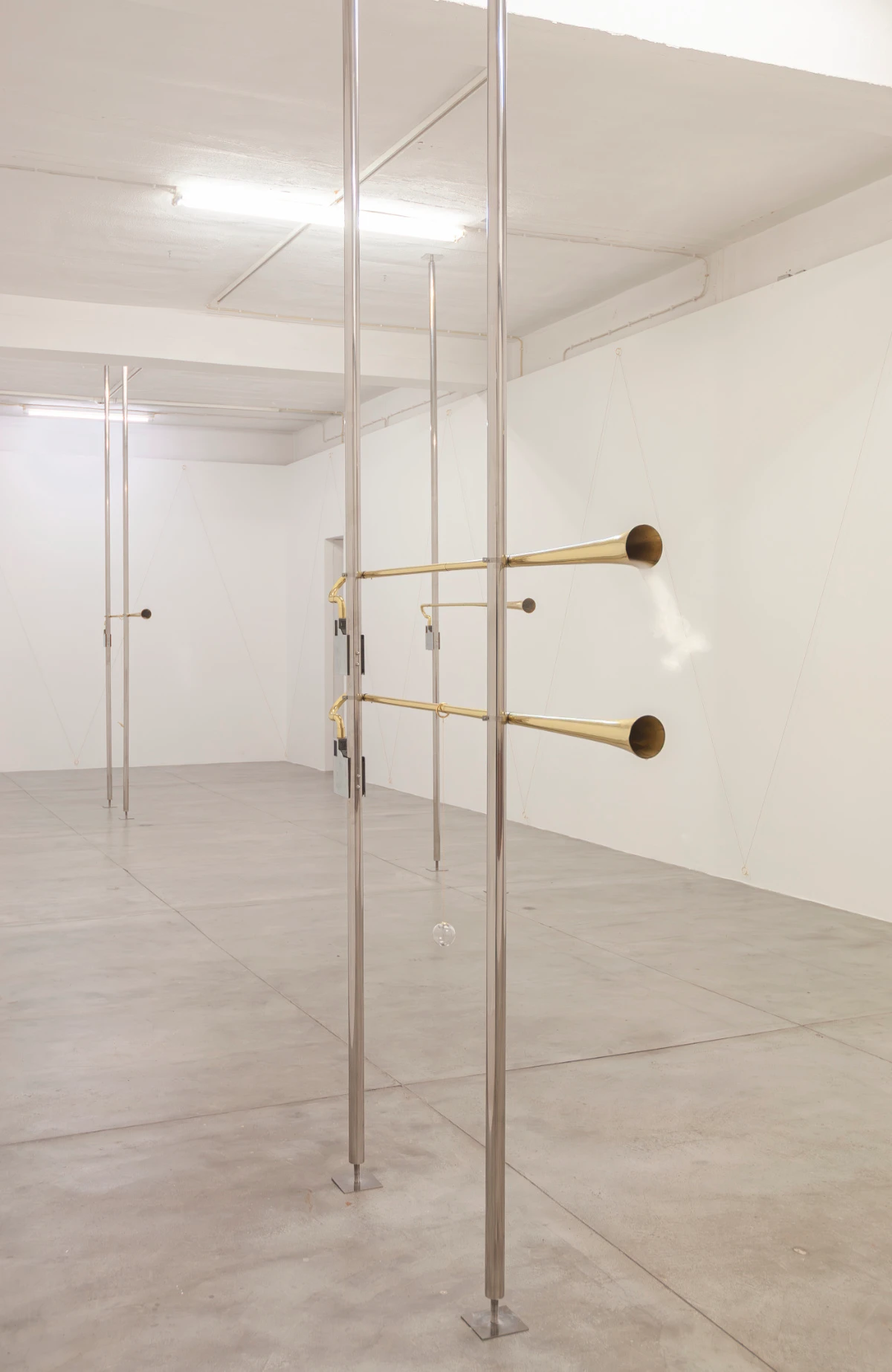interview
Laura Vinci: ‘The exhibition has a very calm quality, with few works. It is precisely a reflection.’
A conversation between Adailton Moura and artist Laura Vinci about her exhibition Fluxus at MuBE (Brazilian Museum of Sculpture and Ecology) in São Paulo, which precedes O Triz (The Nick Of Time), curated by Agnaldo Farias and organized by the Círculo de Artes Plásticas de Coimbra (Coimbra Circle of Fine Arts), open until December 20th at Círculo Sereia.
The conversation took place in front of one of his installations outside MuBE (four pendulums that swing around as though they were ballerinas' legs dancing softly).
Before entering MuBE, one can be impacted by the vapor from one of Laura Vinci's works. The mist, which catches visitors' attention as they pass by on the street, is created by small high-pressure spray nozzles, powered by a pump that allows water to come out with such force that its droplets take on an unusual characteristic, remaining between a state of gas and liquid. Upon passing through the MuBE doors, sight and smell are activated at the same time by a marble table filled with apples. The scent of fruit undergoing physical transformation fills the small room. Upon descending a small staircase, I encounter the artist amid the fumes emanating from the narrow funnel. This is one of the elements of the exhibition Fluxos, which can now be seen in Coimbra.
Your works are completely different, but they interact with each other. How do your ideas come about?
Though each one is unique in its own way, all of these works deal with the issue of time. Each one comes from a different place. For example, the cones, now in Coimbra, derive from a work by (Hieronymus) Bosch. In the center of the work As Tentações de Santo Antão (The Temptations of Saint Anthony) there is a kind of monster, a figure that is half duck, half human, with a beak from which smoke emerges, and which I have been working on since 2002.
And how can they be put into practice?
This, for example (pointing to four pendulums in front of us, resembling the legs of ballerinas dancing softly), is a piece I made for a set at the Municipal Theater of São Paulo, which was six meters high at the time. Then I adapted it, tried to figure out the best place to put it, and opted for the outside of the building, where there is a performance space and a small staircase, which also serves as a grandstand, and where I could build a metal structure to hold the piece's motors. So, I adapted it, cutting it to the size of the slab and the height of the space: four and a half meters.
This structure appears to be dancing…
When I was in theater, everything was related to time. I did a show, Cantos de Maldoror: Terra em Transe, with Nuno Ramos and Eduardo Climachauska, based on the film Terra em Transe by Glauber Rocha. They took the film, transformed the lines into sounds, and divided them into four pitches. They asked me to do four tempos, as if they were four pitches. Each one swings in time. And so, the play looks like a dance. In theater, these points were the lightning rods. And here, for safety reasons, I made this form more docile, which looks like a ballerina's foot.
But the idea behind the exhibition is that one art form complements the other, bringing these different things together to also bring this visualization of what art is, of what it can be.
This exhibition is a collection of various works from 2007 to 2025. These are works developed over almost 20 years. They reflect a little of my career. There is much more work, but, nevertheless. I think that here we ended up choosing works related, above all, to the matter of time. Time, transience, and the transformation of matter... In a way, all the works on show here deal with this issue, even though they're very different from each other. For example, downstairs there is a marble table with apples. When we think of apples, we think of (Paul) Cézanne. But there we also find apples that are organic, living forms, which will rot and which are there alongside that marble table, which is actually almost a tombstone. There we find the question of life and death. After all, what is life and death? It's time. What lies between life and death is time, which passes. We are temporal beings, temporary beings. We are here for a short time. The scent of the fruit is visual, but we also exercise our sense of smell.
Which pieces are being exhibited in Coimbra?
O Triz, which are the steam cones, the little leaves that move, were produced from real leaves. I picked a branch, then they were drawn, transferred to a 3D printer, cast in brass, and gold-plated. This steam outside may not be exhibited. We are still working on it. But the chains on the wall and the sand funnel will also be on display. I actually presented the sand funnel at the third Coimbra Biennial. However, I ended up donating this piece to them because of all the logistics and difficulty of transporting it.
In addition to visual art, you also make other types of art. How does your artistic mind work?
I started performing theater in 1998 with Zé Celso, at Teatro Oficina (São Paulo). I was there for four years and then worked with several companies. For me, theater has a great quality, which is precisely the fact that it is very collective. It's impossible to make theater alone. It's a group effort. And I think that, in the end, theater also ended up bringing me things very unconsciously. For example, in this work with steam, the audience is physically attracted to it. Children, adults, everyone is there. And there is some kind of physical appeal, a stimulus for the audience. Everyone wants to go to the steam and feel that sensation. And for me, steam is very much like a portal to new worlds. It's as if you were there and entered another place.
There's that steam, the smoke from the cone, and the smoke from the windows…
They are different types of smoke. They are not the same.
But what is the difference between them in their creation?
For example, I think of the smoke from the cone as a gateway to imagination, to thinking about new worlds. In the case of glass, there is another matter. Here, the steam is less aggressive, but when I staged this piece in São Paulo and Rio de Janeiro, as part of a play, the smoke came out with greater intensity. This piece has a slightly more dystopian, more violent character, reminiscent of the end of the world. When we set it up here, I thought the steam couldn't have that violence because it would dominate the space too much and perhaps overshadow the other works. So, I reduced it, controlled it, and decreased the size of the machine. And O Triz, which are the cones, I think is a kind of last breath. We are at a moment when something is losing steam. This piece really reflects the moment we are living in the world, both politically and climatically. We are in a very complex moment.
What role does art play in conveying these messages?
When art is good, it can convey all these things, not in words, but in feelings and emotions. The exhibition is of a very calm quality, involving few works. It is a reflection. To be calmer, to perceive, to pause, to observe, to listen, to smell. To feel, to notice.
You've always emphasized that your work is individual, but it's also collective, isn't it? How does the creation and development process work?
Yes, for example, I don't know how to create these engines, but I have a few partners. They are people who complement my work, because I couldn't do it alone. I really like it. In fact, I need it. Not only do I need it, but I also think it's important to work collaboratively. I have a large team that helps me. It's like theater, which you can't do alone. I think there are artists, like painters, for example, who have a very solitary approach, a daily routine, a very lonely studio life. I'm not like that: I like to go out on the street, I like to go to suppliers, discover new possibilities... I mean, I think I'm a person who likes to create situations where I can do things together.
But when it comes to getting it out of your head, putting it on paper, and then executing it, how does it work?
For example, O Triz was very much like that. I saw the painting and took it for myself. Then I went to the studio and racked my brains there, alone. I think about the system myself. It's funny because sometimes you have visions. This [the pendulums] was a vision, I don't know why. It just came. This generates various types of art. It's not a single thing. I mean, there's only one subject, which is this question of time, but it goes through different materials, different types of situations, different types of time. The rock's time is a different time; it was once sand and will be sand again. Only much greater than ours, geological. We don't have geological time; we don't have time to last. Our time is short.
Art helps us think about these issues. It makes us pause in life, for in the daily rush we don't think about how quickly time passes.
What are we? We are existence... nothing more than that. So, what do we do with this existence? We have to give it meaning, to take an interest in it.
As life goes on, we end up ignoring it.
It's because our capitalist culture forces us to work to earn money, isn't it? We may even think that it's not necessary, that we can go with the flow, enjoy life more... But we can't. Actually, we can, and art plays that role. It's hard, but it's feasible.
ADVERTISING
Previous
article
-m8btp.jpg)
17 Nov 2025
36th São Paulo Biennial - Human Inside and Outside the Human Body
By João Victor Guimarães
Next
article

18 Nov 2025
The Museum as Performance, at Serralves
By Débora Valeixo Rana
Related Posts
